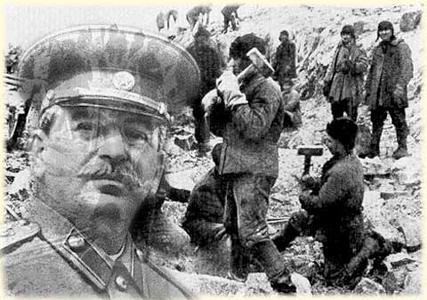
In 1933 6.000 people were deported by the Russian government to Nazino, a remote island. There, left without shelter or enough food, episodes of cannibalism started. Only 2,000 people survived, but 1,700 were in desperate conditions. The island is now known as the “island of the cannibals” or “island of death”.
History
In the 30 Stalin had wanted a project for rapid industrialization of the country. To do so all the wealth produced by agriculture was to be devolved to the industry.
By doing so the properties of the peasants were collectivized: the entire harvest of the farmers was confiscated and they were not left with even the bare minimum to survive.
This gave rise to a serious famine that claimed millions of deaths. This project began in 1927 in Ukraine and in 1930 it was implemented in Russia.
In this way all the peasants living in rural areas began to move, now deprived of their land, to urban areas. Soon the number of refugees had become huge and the food was not enough for everyone.
The government then introduced a passport to enter Russia: those who did not have it were deported to Siberia or Kazakhstan. Many farmers were denied to enter urban areas and were sent back to the countryside.
Those who opposed this system or sought to enter “illegally” were detained or killed. The new enemy for Stalin was “social deviance” and soldiers had orders to arrest anyone who “looked suspicious”.
Most of the “criminals” were mainly peasants who were just trying to survive.
Stalin then decided to send these prisoners to uninhabited areas and let them cultivate the virgin land, starting in this way new colonies.
The Nazino affair
In 1933 the head of Russian secret police Genrikh Yagoda and the head of Gulag Matvei Berman presented to Stalin the “grand design” through which thousands of people would have been moved to Siberia and Kazakhstan in order to cultivate the land and start new colonies.
The project involved the displacement of the “criminals” on the route Tomsk-Omsk-Achinsk to end up then on the island of Nazino.
The shift of the first deportees began at the end of April and 10 May the various convoys arrived in Tomsk. The daily ration for each prisoner was 300 grams of bread; however, as already mentioned, the majority of the prisoners were poor peasants who found themselves deported together with real criminals.
These criminals were abusing the poor peasants stealing their food and clothing.
The 6,000 deportees arrived on the island of Nazino, 3 kilometers long and 600 meters wide at its widest point, on the 18th May 1933. Brigades were set up,of 150 people each, and headed by a brigadier, usually a criminal.
The acts of cannibalism and the end of the project

Four days after the arrival of the deportees on the island of Nazino, the first episodes of cannibalism began. On May 21, five events were counted. On May 22nd they received flour, which was handed over to the brigadiers to make fair rations. Needless to say, the brigadiers took advantage of the situation, stealing many rations.
The food, however, consisted of only flour and with no ovens to cook, many ended up mixing it with river water and eating a mushy concoction, which caused an epidemic of dysentery.
Given the extreme situation, many people tried to flee using rafts, but died in the attempt and their bodies were found ashore.
On May 27, another 1,200 prisoners arrived on the island and some of the survivors of the first group were moved to other settlements on the island, but many died on the way. The rest had to deal with an epidemic of typhus.
In July, new settlements were built on the island, but in a report dated 2nd August 1933 it’s stated that only 2,000 of the prisoners had survived, of which only 300 were in good condition.
This project was later hidden and its details became public knowledge in 1988 thanks to the association “Memorial”.












Socialism at work.
Socialism at work.